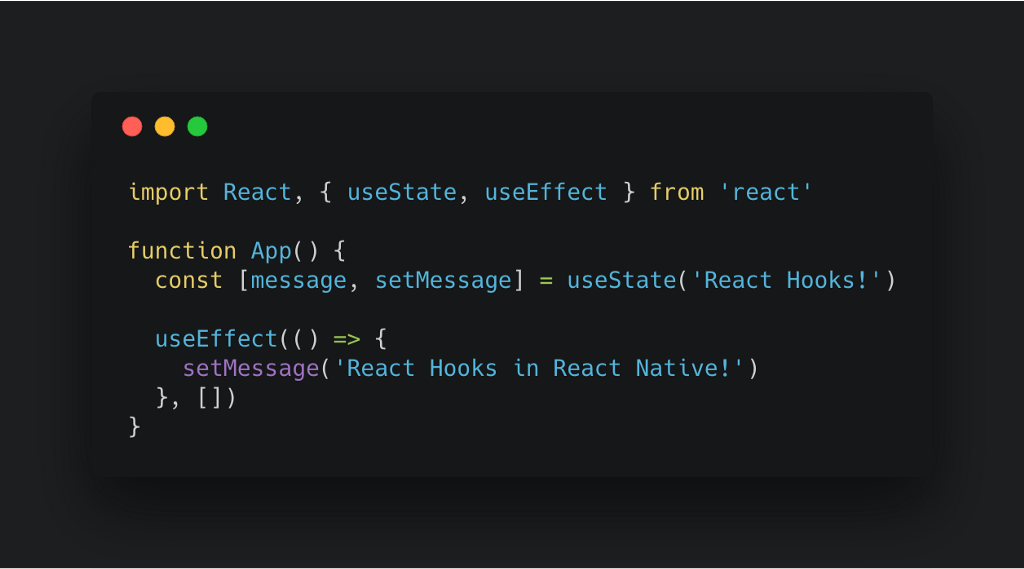
The introduction of Hooks in React 16.8.0 was initially met with a dose of skepticism. The developers soon found it an outstanding addition that allowed for a much more declarative and efficient solution to writing code.
Currently, two years later, Hooks have become a standard part of the React ecosystem, and there is a push to use Hooks over Class Components.
How Hooks Replace Class Components
The primary purpose of using the Class Component was to obtain access to the state and the life cycle methods, which were unavailable in the Functional Components. Hooks allows the use of these features in the Functional Components , without using the less performant Class Component counterparts.
Let’s look at the Hooks that ship with React. It is assumed that you are familiar with the basics of React
Hooks
Bear in mind that hooks presented below are only examples. There are many more hooks available out there.
useState
The useState hook is used to create thing called state variable.
The syntax is const [<varName>, set<varName>] = useState(initialState).
function Counter() {
const [count, setCount] = useState(0);
return (
<div>
<h2>{count}</h2>
<button onClick={() => setCount(count + 1)}>Increment</button>
</div>
);
}
We can use the setCount function to update the state of the count variable. Just compare it to the Class Component counterpart:
class Counter extends React.Component {
state = {
count: 0,
};
render() {
return (
<div>
<h2>{this.state.count}</h2>
<button
onClick={() =>
this.setState({
count: this.state.count + 1,
})
}
>
Increment
</button>
</div>
);
}
}
Not only does Functional Components are more performant, but they are also easier to read and understand.
useEffect
useEffect is another standard Hook. Its principal purpose is to execute life cycle methods in a Functional Component.
Let’s explore the life cycle methods you can replace:
componentDidMount
componentDidMount runs when the component is mounted. It is typically used to fetch data through API calls and update the state. The Hook alternative is:
useEffect(() => {
// execute when component is mounted
}, []);
componentDidUpdate
componentDidUpdate runs when a piece of state or prop data is updated. It is used to update associated data once a piece of data is updated. The Hook alternative is:
useEffect(() => {
// execute when `count` is updated
}, [count]);
You can also omit the dependency array ([count] in this case) if you only want to run the useEffect callback run on every render.
componentWillUnmount
componentWillUnmount runs before the component is unmounted. It is used as a clean-up function, with the primary focus on removing timers or listeners
The Hook alternative is:
useEffect(() => {
return () => {
// execute when component will be unmounted
};
}, []);
useContext
The useContext Hook allows you to access the context, the state management solution that ships with React. The syntax is const <varName> = useContext(<Context>).
function Counter() {
const { count, setCount } = useContext(CounterContext);
return (
<div>
<h2>{count}</h2>
<button onClick={() => setCount(count + 1)}>Increment</button>
</div>
);
}
NOTE: The Component needs to be wrapped in a Context.Provider Component as it looks up the React Virtual DOM for the Context
useRef
useRef is a Hook that allows you to store a variable that persists between the re-renders.
The main difference between a state and ref variables is when a state variable is updated, the UI is re-rendered, whereas, it does not do the same for a ref. It is generally used to store a reference to DOM elements.
The syntax is const <varName> = useRef(initialValue) and the value is accessible through the current property.
function FancyDiv() {
const div = useRef();
const handleClick = () => {
// `div.current` is a reference to the DOM element
div.current.style.color = "red";
};
return (
<>
<div ref={div}>{/* ... */}</div>
<button onClick={handleClick}>Click me</button>
</>
);
}
useCallback
useCallback is a Hook that allows you to memorize (an optimization practice in Computer Science) a function. It is useful when you want to prevent unnecessary renders.
The syntax is const <varName> = useCallback(<function>, [<dependencies>]);
function Component() {
const memoizedCallback = useCallback(() => {
doSomething(a, b);
}, [a, b]);
return (
/* ... */
);
}
useMemo
useMemo is a Hook that allows you to memoize any value. Just like useCallback, it is beneficial to prevent unnecessary renders. It is generally used to memoize expensive computations.
The syntax is const <varName> = useMemo(<function>, [<dependencies>]);
function Component() {
const memoizedValue = useMemo(() => {
return computeExpensiveValue(a, b);
}, [a, b]);
return (
/* ... */
);
}
useReducer
useReducer is a Hook that allows you to manage the state of a component. It serves the same purpose as the useState Hook , but it follows the Redux pattern to manage & update the state.
The syntax is const [<varName>, dispatch] = useReducer(<reducer>, initialState);
const initialState = { count: 0 };
function reducer(state, action) {
switch (action.type) {
case "increment":
return { count: state.count + 1 };
default:
throw new Error();
}
}
function Counter() {
const [state, dispatch] = useReducer(reducer, initialState);
return (
<div>
<h2>{state.count}</h2>
<button onClick={() => dispatch({ type: "increment" })}>
Increment
</button>
</div>
);
}
Custom Hooks
React also allows developers to create their own Hooks from scratch.
Let’s create a custom Hook called useFetch, which will fetch data from an API and return it along with loading & error states.
function useFetch(url) {
const [data, setData] = useState(null);
const [loading, setLoading] = useState(true);
const [error, setError] = useState(null);
useEffect(() => {
(async () => {
setLoading(true);
try {
const response = await fetch(url);
const jsonData = await response.json();
setData(jsonData);
} catch {
setError(error);
}
setLoading(false);
})();
}, [url]);
return { data, loading, error };
}
